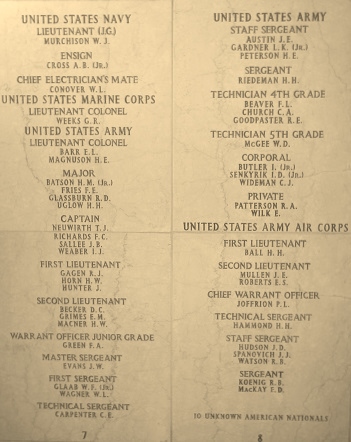Memorial Day, Yokohama Cremation Memorial, Commonwealth War Cemetery, Hodogaya, Japan
Originally called Decoration Day, Memorial Day is observed in the United States on the last Monday of May each year to honour those military personnel who died in the service of their country. It was first observed as a national day of mourning on 30 May 1868 when flowers were placed on the graves of Union and Confederate soldiers at Arlington National Cemetery in Virginia. Military deaths in that fratricidal Civil War exceeded 620,000, about the same as those who died in the American Revolution, the War of 1812, the Mexican War, the Spanish-American War, World War I, World War II and the Korean War combined, with about half never identified. Although recognised by all Northern states, the South only acknowledged Memorial Day after World War I when it became a day of reconciliation for all Americans to commemorate those who died in service in all wars, rather than just the Civil War.
The first post-WWII Memorial Day Service in Japan was conducted on 28 May 1946 at USAF Cemetery No. 1, Yokohama, located on the grounds of the present-day Yokohama Country & Athletic Club at Yaguchidai, Naka-ku, Yokohama. Representatives of all US military services and all Allied Forces participated in the Service at this temporary cemetery, where the remains of Americans and Allies who crashed during air raids over Japan, who died in POW camps in Japan or during the Occupation period were buried before final interment.
While Commonwealth countries adopted a policy of interring those who died in service overseas where they fell, the final resting place of US military personnel who died overseas since the First World War has been determined by their next of kin. The remains of their loved ones could be returned to the United States (or the homeland of the deceased or of the next of kin) for burial in a private cemetery, or be interred in a national cemetery in the United States or in a permanent US military cemetery overseas. Consequently, most of the over 1,100 Americans who died in POW camps in Japan during World War II are interred in the largest permanent US military cemetery on foreign soil, the Manila American Cemetery in the Philippines, in national cemeteries such as the National Memorial Cemetery of the Pacific in Honolulu, Hawaii, Arlington National Cemetery in Virginia and others in over 130 locations across the continental United States, or otherwise buried privately in local cemeteries throughout the US, usually in the hometown of the deceased.
However, the remains of a small number of US POWs who died in Japan were not repatriated as they could not be distinguished from among the 335 soldiers, sailors and airmen of the Commonwealth, the Kingdom of the Netherlands and the United States who were originally cremated and buried in a communal grave near a POW camp in the port city of Moji (now part of the city of Kitakyushu) in Fukuoka Prefecture. Their ashes are contained in an urn housed in the Yokohama Cremation Memorial, a beautiful and dignified shrine erected on the eastern edge of the British Section of the Commonwealth War Cemetery, Hodogaya. The names of 284, including 48 Americans are inscribed on the walls of the shrine, while the identities of the other 51 remain unknown.
It is on these hallowed grounds that Post 1054 of the Veterans of Foreign Wars of the United States, the largest US organisation of combat veterans, which is based at US Fleet Activities, Yokosuka hosts a Memorial Day Service on the Sunday preceding Memorial Day each year. The Royal British Legion's Tokyo Branch joins representatives of all branches of the US military, Allied Forces and other organisations such as the Boy Scouts of America in paying tribute to those who died in service to their country. Over one million US service personnel have lost their lives in wartime periods, including more than 300,000 who were killed overseas during World War II - over 80,000 of those falling in the Pacific Theatre or on the Asian mainland.
The VFW Memorial Day Service began with Posting the Colours, an opening prayer, words of greeting and expressions of the nation's gratitude to those who paid the ultimate sacrifice for all we take for granted today from the Commander, VFW District 2, Mainland Japan. He also invoked the red poppy of remembrance through recitation of Moina Michael's poetic response to Lt. Col. John McCrae's poem, "In Flanders Fields":
"We cherish too, the poppy red / That grows on fields where valour led. / It seems to signal to the skies / That blood of heroes never dies."
In the US, poppies are traditionally worn on Memorial Day to honour the country's war dead rather than 11 November (Veterans' Day). Moina Michael was the first to wear one on Memorial Day and to sell poppies, with the money going to benefit servicemen in need. In 1922, the VFW became the first veterans' organisation to sell poppies nationally.
The VFW Memorial Day Service continued with the Naval Two Bell Ceremony honouring departed sailors and shipmates, the playing of Taps and a moment of silence. Then VFW Post Commanders along with US and Allied Military Forces and service organisation representatives placed wreaths and flowers within the Cremation Memorial in silent tribute to those who sacrificed their lives for their nation. The Service concluded with a closing prayer and Retiring the Colours.
Memorial Day has represented a day of reconciliation and healing the wounds of war for almost 100 years. At the Yokohama Cremation Memorial, it also marks a day to honour the fallen - united in adversity, undivided in death, many unknown - and provides an everlasting symbol of national and international collective remembrance of a debt which can never be repaid.

Memorial Day 2014, Yokohama Cremation Memorial, Commonwealth War Cemetery, Hodogaya, Japan
Please click a photo in our gallery below to enlarge it.
Error loading Partial View script (file: ~/Views/MacroPartials/rblGallery.cshtml)